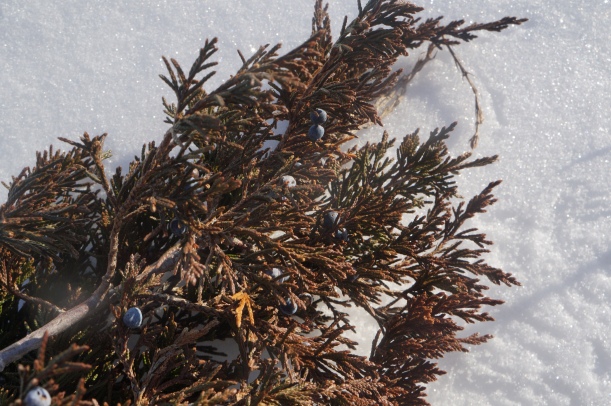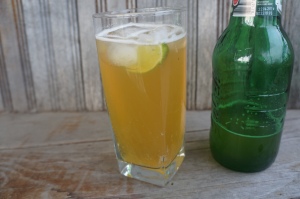 When I read today’s Fiesta Friday post, one recipe featured from last week particularly caught my eye and I decided to make it right away. Unwilling to go shopping I had to make do with either what I had in my own kitchen or garden, and by the time I finished I had used in my version, still recognizable as Monika’s, a few ‘new’ ingredients I thought worth sharing.
When I read today’s Fiesta Friday post, one recipe featured from last week particularly caught my eye and I decided to make it right away. Unwilling to go shopping I had to make do with either what I had in my own kitchen or garden, and by the time I finished I had used in my version, still recognizable as Monika’s, a few ‘new’ ingredients I thought worth sharing.
The recipe I refer to is one for Pomegranate Beet Salsa by Monika at Everyday Healthy Recipes. It is the perfect dish for these hot dry days- simple to prepare, keeps well, and as good on its own as it is a side dish. Thank you Monika!
The so-called new ingredients in my recipe are red currants (ribes rubrum) and Queen Anne’s lace (daucus carota) leaves. The currants I have used before to make salad dressing and mayonnaise, but I had never thought of putting them whole into a salad. They are found in much of North Eastern US and Eastern Canada. Once established they thrive in sunny spots, and apparently are drought resistant given that they are still thriving in our back yard desert. One source I read describes them as a brilliant red skin encasing a pulpy flesh that contains 3-12 tiny edible seeds with flavours of raspberry, cranberry, gooseberry, rhubarb and a hint of rose. That sounds about right to me. Many sources say they are delicious as long as you add lots of sugar, which explains why they are most often used to make jelly. However, used sparingly in a savoury dish such as this one, no sugar is needed.
As for the Queen Anne’s lace, there is so much of it blooming right now, but I had not given any thought to anything other than the flowers. I know that all parts of the plant are edible and often see reference to the leaves as being good in salads, but have never seen a salad recipe that calls for them. For identification and further information on this plant, please check here.
Again, the herbs I used are all from my garden, but this salad is versatile, and you can make your own mix of greens to add. As for the oil, I used my black walnut infused oil, and I think any nut oil would be good, or just a good quality oil as Monika suggests, such as grape seed oil.
Beet and Red Currant Salad
3 Tbsp finely chopped red onion
3 Tbsp balsamic vinegar
2 cups chopped beets, previously boiled, cooled and peeled
2 Tbsp chopped Queen Anne’s lace leaves
1 heaping Tbsp each of fresh mint and dill
2 Tbsp oil
salt and pepper to taste
3/4 cup red currants
Put the onion and vinegar in a bowl and allow to sit while preparing the other ingredients. Add everything except the currants and mix well. Gently fold in the currants. Refrigerate for at least an hour before serving for best flavour.
 Linked to: Fiesta Friday #233
Linked to: Fiesta Friday #233





 Since I began working on this blog, I have found two things about foraging which surprise me. First, that you can forage quite happily in the winter even in this snowiest of landscapes for some really worthwhile ingredients, one of which I am writing about today. In fact, the winter has the advantage of being insect-free, and as long as there’s not a blizzard and you are dressed for it, the venture is very invigorating and a great excuse to enjoy the outdoors. Just don’t remove gloves for too long while you take photographs or snip branches, both of which are impossible with furry gloves.
Since I began working on this blog, I have found two things about foraging which surprise me. First, that you can forage quite happily in the winter even in this snowiest of landscapes for some really worthwhile ingredients, one of which I am writing about today. In fact, the winter has the advantage of being insect-free, and as long as there’s not a blizzard and you are dressed for it, the venture is very invigorating and a great excuse to enjoy the outdoors. Just don’t remove gloves for too long while you take photographs or snip branches, both of which are impossible with furry gloves.











 We have had a few light frosts already but the ground is wet and unfrozen. This means it’s the best time to harvest some of my favourites, among them sunchokes or Jerusalem artichokes. I have written several posts on these tubers, but if you are not familiar with them, refer to this
We have had a few light frosts already but the ground is wet and unfrozen. This means it’s the best time to harvest some of my favourites, among them sunchokes or Jerusalem artichokes. I have written several posts on these tubers, but if you are not familiar with them, refer to this 












